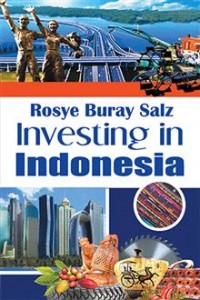Title: Investing in Indonesia
Author: Rosye Buray Salz
Publisher: XlibrisUS
ISBN: 978-1-5144-7442-6
Pages: 330
Genre: Business & Economics / International
Reviewed by: J. W. Bankston
Buy on AmazonPacific Book Review
At first glance, Indonesia is an unlikely prospect for an investment guide. Neither one of the well-known BRICS economies (Brazil, Russia, India, China and South Africa) nor a member of the region’s successful Four Asian Tigers (Hong Kong, Singapore, South Korea and Taiwan), Indonesia is often passed over for consideration. Its inclusion in the less familiar CIVETS (Colombia, Indonesia, Vietnam, Egypt, Turkey and South Africa) or as an occasional addition to BRICS (thus the unwieldy acronym BRIICS) doesn’t do justice to the archipelago’s potential.
With Investing In Indonesia, author Rosye Buray Salz makes a compelling case for anyone considering developing a business in the fourth most populated country in the world. Using clear prose along with numerous charts, graphs and maps, Salz provides neophytes with an introduction to Indonesia’s history, government and its strategic location between Singapore and Australia. Although investors already versed in the nation’s political and judicial systems may skip the early sections, Investing in Indonesia soon shifts tone to the more complex requirements for foreign investment.
As a U.S. citizen born in South Kalimantan, Indonesia, Salz is uniquely positioned to provide expertise for anyone considering investing in the country. Having worked for multinational manufacturing corporations in both Indonesia and Australia, she understands the obstacles endured by anyone seeking opportunity in a nation that was ranked #99 in the 2016 Index of Economic Freedom — between Lebanon and Mongola (the U.S is #11). Salz doesn’t ignore these challenges. She addresses many of the concerns expressed by the Index, including corrupt civil servants, competing licensing requirements and regulations favoring state-owned enterprises. The author presents the various reforms that have been recently implemented including efforts to reduce corruption.
The work is less about highlighting the advantages of “Investing in Indonesia,” than a compendium of requirements. Readers will learn about the steps to, for instance, acquire land or obtain necessary licenses. Although Indonesian citizens have enjoyed free and fair elections for almost 20 years (it’s the largest Muslim majority democracy in the world), Salz believes that the “Indonesian Government is aware that the quality of governance is a prerequisite to achieve national development goals, both short term, medium term and long term. The Government needs to share power with the private sector and civil societies.”
There are sections within Investing in Indonesia that are so detailed as to become unwieldy. This book isn’t intended for casual reading, although it also doesn’t presuppose any knowledge about the region on the part of the reader. Despite the sometimes-dense reportage, Salz ultimately achieves the objective laid out in the preface: “To attract investors to Indonesia, demystify the investment process and accelerate your profitability.”


